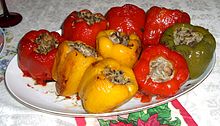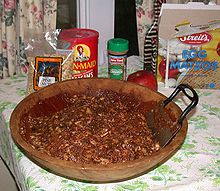Sephardic Jewish cuisine
The Western Sephardim, also known more ambiguously as the Spanish and Portuguese Jews, left Spain and Portugal as New Christians in a steady stream over the next few centuries, and converted back to Judaism once in Holland, England, etc.This period saw the development of a well-established culinary tradition that not only reflected the broader food culture of medieval Spain but also featured ingredients like eggplant, chard, and chickpeas, which became closely associated with Jews in this area.[2] According to Sara Gardner, during this period, Sephardic women played a crucial role in preserving cultural identity, especially as communal institutions collapsed.[2] Upon their settlement in the Ottoman Empire, Sephardic Jews began the process of recreating their Spanish culinary heritage despite the lack of familiar ingredients and cooking methods.Sephardic women adapted local ingredients and techniques, resulting in the creation of new dishes such as tishpishti, a semolina cake soaked in syrup, and pishkado ahilado, a stew of fried fish with tomato sauce.This adaptation illustrates the evolution of Sephardic cuisine within its new context, while retaining elements from its Iberian origins and reflecting both continuity and change across the Mediterranean.[2] Sephardic Jews also settled in various regions worldwide, developing distinct cuisines influenced by local ingredients and cooking methods.[citation needed] In 1654, 23 Sephardic Jews arrived in New Amsterdam (present-day New York) bringing this cuisine with them to the early colonial United States.Consequently, the cuisine of Jerusalem is predominantly Sephardic, featuring dishes such as slow-cooked meat stews, stuffed vegetables, and a variety of savory pastries, including pastelitos, borekitas, and biscochos.[7] Sephardi cuisine emphasizes salads, stuffed vegetables and vine leaves, olive oil, lentils, fresh and dried fruits, herbs and nuts, and chickpeas.Tiny cups of Turkish coffee, sometimes spiced with cardamom, are often served at the end of a festive meal, accompanied by small portions of baklava or other pastries dipped in syrup or honey.As cooking on Shabbat is prohibited, Sephardi Jews, like their Ashkenazi counterparts, developed slow-cooked foods that would simmer on a low flame overnight and be ready for eating the next day.These rings are adorned with small dough sculptures, including representations of Miriam's well, the Ten Commandments, an open Torah scroll, a dove symbolising the Jewish people, and the copper serpent stick created by Moses as a sign for repentance and healing.







Mizrahi Jewish cuisineİzmir, TurkeyOttoman cuisineSephardic JewsJewishpopulationIberian Peninsulaexpulsiontraditional dishesOttoman EmpireNorth AfricaMediterraneanTurkeyGreeceBulgariaNorth MacedoniaLand of IsraelWestern SephardimHollandEnglandcuisine of Jerusalemmedieval traditionsbourekaspastrieseggplantvegetablescheesetomato sauceagristadatishpishtisemolinabaklavacookiesbiscochosqurbayelJudaeo-SpanishTurkishJewish ethnic divisionsSephardimkashrutconvertChristianityNorth-AfricanBerberArabicMoroccoTunisiaAlgeriaEastern SephardimSpanish and Portuguese JewsNew ChristiansJudaismGreater Middle EastMizrahimkosherJewish statemedieval SpainMuslimchickpeasKitāb al-ṬabikhAl-AndalusmoflettapancakeMoroccan JewsMimounachallahAshkenazi cuisineexpulsion of Jews from SpainadafinaShabbatalmodrotecasserolecrypto-JewsSpanish InquisitionOttoman culinary stylesfilo pastryRecifeBrazilmolassesvanillachocolatebell pepperstomatoeskidney beansstring beansNew AmsterdamNew Yorkcolonial United Statestraditional holidaysalmond puddingsegg custardsPhiladelphiaJerusalemslow-cookedpastelitosLevantine ArabAshkenaziKurdish JewishcilantroturmericCardamomCinnamonma'amoulTurkish coffeesahlabMalabiMahane Yehuda Marketropa viejachaminshaletboiled eggbulemasSambusakSabbathfruit preservesRosh Hashanarodanchaskeftedes de prasaHanukkahbimueloskeftesCharosetPassoverkitniyotShavuotseven heavens
